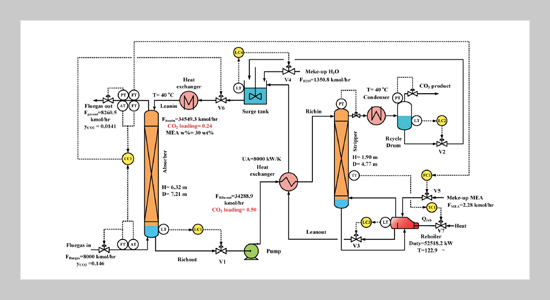REFERENCES
- [1] The Global Status of CCS: 2018. Available online: https://www.globalccsinstitute.com/resources/ global-status-report/ (accessed on 22 Dec. 2018).
- [2] Luis, P. (2016) Use of monoethanolamine (MEA) for CO2 capture in a global scenario: consequences and alternatives, Desalination 380, 93�99. doi: 10.1016/j. desal.2015.08.004
- [3] Kohl, A. L., and R. B. Nielsen (1997) Gas Purification, 5th ed., Gulf Professional Publishing, Houston USA.
- [4] Aspen Technology (2018), Inc., Aspen Plus V10.
- [5] Walters, M. S., T. F. Edgar, and G. T. Rochelle (2016) Dynamic modeling and control of an intercooled absorber for post-combustion CO2 capture, Chemical Engineering and Processing 107, 1�10. doi: 10.1016/ j.cep.2016.05.012
- [6] Nittaya, T., P. L. Douglas, E. Croiset, L. A. RicardezSandoval(2014) Dynamicmodelling and controlof MEA absorption processes for CO2 capture from power plants, Fuel 116, 672�691. doi: 10.1016/j.fuel.2013.08.031
- [7] Panahi, M., and S. Skogestad (2011) Economically efficient operation of CO2 capturing process part I: selfoptimizing procedure for selecting the best controlled variables, Chemical Engineering and Processing 50, 247�253. doi: 10.1016/j.cep.2011.02.005
- [8] Ziaii, S., G. T. Rochelle, and T. F. Edgar (2009) Dynamic modeling to minimize energy use for CO2 capture in power plants by aqueous monoethanolamine, Industrial and Engineering Chemistry Research 48, 6105�6111. doi: 10.1021/ie801385q
- [9] Zhang, Q., R. Turton, and D. Bhattacharyya (2016) Development of model and model-predictive control of an MEA based postcombustion CO2 capture process, Industrial and Engineering Chemistry Research 55, 1292�1308. doi: 10.1021/acs.iecr.5b02243
- [10] Aspen Technology (2015), Inc., Jump Start: Aspen Custom Modeler, V8.
- [11] Walters, M. S., Y. J. Lin, D. J. Sachde, T. F. Edgar, and G. T. Rochelle (2016) Control relevant model of amine scrubbing for CO2 capture from power plants, Industrial and Engineering Chemistry Research 55, 1690� 1700. doi: 10.1021/acs.iecr.5b04379
- [12] Freguia, S., and G. T. Rochelle (2003) Modeling of CO2 capture by aqueous monoethanolamine, AIChE Journal 49, 1676�1686. doi: 10.1002/aic.690490708
- [13] Luu, M. T., N. A. Manaf, and A. Abbas (2015) Dynamic modelling and control strategies for flexible operation of amine-based post-combustion CO2 capture systems, International Journal of Greenhouse Gas Control 39, 377�389. doi: 10.1016/j.ijggc.2015.05.007
- [14] Harun, N., T. Nittaya, P. L. Douglas, E. Croiset, and L. A. Ricardez-Sandoval (2012) Dynamic simulation of MEA absorption process for CO2 capture from power plants, International Journal of Greenhouse Gas Control 10, 95�309. doi: 10.1016/j.ijggc.2012.06.017
- [15] Danckwerts, P. V. (1970) Gas-Liquid Reactions, Mc Graw-Hill, New York USA. doi: 10.1149/1.2407312
- [16] Billet, R., and M. Schultes (1999) Prediction of mass transfer columns with dumped and arranged packings, updated summary of the calculation method of billet and schultes, Chemical Engineering Research and Design 77, 498�504. doi: 10.1205/026387699526520
- [17] Bird, R. B., W. E. Stewart, and E. N. Lightfoot (2007) Transport Phenomena, Revised 2nd ed., John Wiley & Sons, New York, USA.
- [18] Stichlmair, J., J. L. Bravo, and J. R. Fair (1989) General modelfor prediction of pressure drop and capacity of countercurrent gas/liquid packed columns, Gas Separation and Purification 3, 19�28. doi: 10.1016/ 0950-4214(89)80016-7
- [19] Flø, N. E., H. Knuutila, H. M. Kvamsdal, and M. Hillestad (2015) Dynamic model validation of the postcombustion CO2 absorption process, International Journal of Greenhouse Gas Control 41, 127�141. doi: 10.1016/j.ijggc.2015.07.003
- [20] Luyben, W. L., and M. L. Luyben (1997) Essentials of Process Control, McGraw-Hill, New York, USA.
- [21] Rivera, D. E., M. Morari, and S. Skogestad (1986) Internal model control 4. PID controller design, Industrial Engineering and Chemical Process Design and Development25, 252�265. doi:10.1021/i200032a041
















